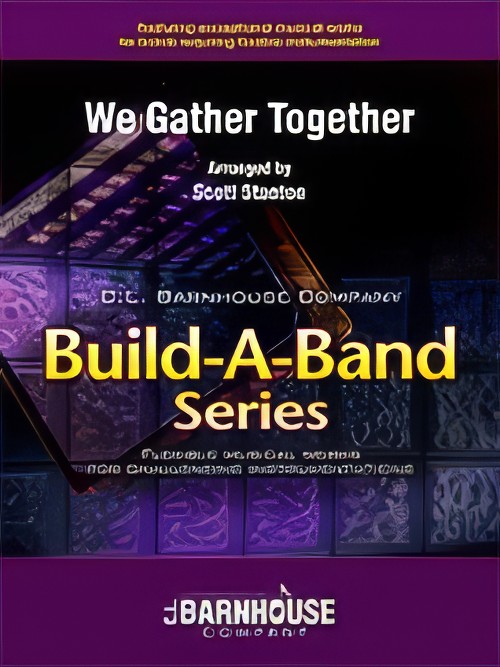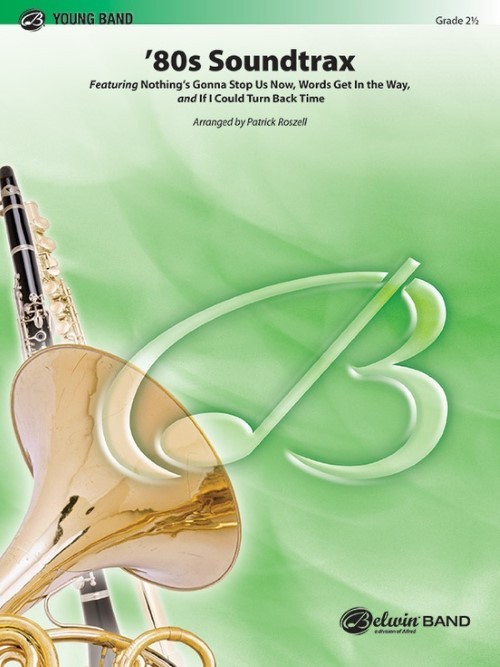Results
-
 £60.00
£60.00We Gather Together (Flexible Ensemble - Score and Parts) - Kremser, Eduard - Stanton, Scott
The famous Dutch hymn "We Gather Together" is scored for small bands with limited instrumentation, but will sound great with bands of all sizes! Dedicated to the Frontline Responders and Essential Workers who keep us safe, this is the perfect "welcome back" piece for both the band and your returning audience. With "Build-A-Band scoring, you get to create unique sounds using the strengths of your instrumentation, and by following the suggested flexible interplay between sections. This beautiful arrangement includes optional vocal parts for performers and/or audience. Piano, bass, guitar and percussion can strengthen your sound as well. Flexible works wonders, and it's perfect for distance learning situations! Duration: 3.30
Estimated dispatch 7-14 working days
-
 £67.00
£67.0080s Soundtrax (Concert Band - Score and Parts) - Roszell, Patrick
Big hair and big hits, the '80s had a sound of its own. '80s Soundtrax presents three big hits from the decade: Nothing's Gonna Stop Us Now; Words Get in the Way; If I Could Turn Back Time. Put on your whitewashed jeans and grab your walkman for a stroll down memory lane! Featuring the works of Starship, Gloria Estefan with the Miami Sound Machine, and Cher. Duration: 4:30
Estimated dispatch 7-14 working days
-
 £41.58
£41.58Nighthawk (Concert Band - Score and Parts)
A slow, dark, and mysterious theme serves as a prelude to a new section that explodes with rhythmic energy. Instruments scored where they sound their best, layered themes, interesting harmonies, and a variety of percussion parts all combine to create an exciting musical journey from start to finish. The crafting of this piece will help make your students sound advanced for their age. Very Impressive!
Estimated dispatch 7-14 working days
-
 £51.48
£51.48Tailspin!
Inspired by a memorable commuter jet trip taken by the composer, "Tailspin!" is an aggressive and hard hitting composition capturing the peril of an airliner in rapid descent. Contemporary harmonies and driving rhythms contribute to the unique and fresh sound of this work. Varied dynamics and textures add to the drama and make this the perfect concert or festival work for young bands. Creative and skillful scoring makes this sound much harder than it actually is. "Tailspin!" Has the excitement and power that students love!
Estimated dispatch 7-14 working days
-
 £53.50
£53.50Wind Machines - Robert Buckley
Wind Machines can refer either to the various machines that are driven by the wind, or the soaring sound of a wind band. In a cinematic style, this composition takes us high in the sky, soaring above the majestic landscape in a glider. The bold rhythms, effective scoring and artful interplay between sections gives this piece the sophisticated sound and intensity of a much more advanced piece. Dur: ca. 2:20
Estimated dispatch 7-14 working days
-
 £61.50
£61.50Tailspin! - Rob Romeyn
Inspired by a memorable commuter jet trip taken by the composer, "Tailspin!" is an aggressive and hard hitting composition capturing the peril of an airliner in rapid descent. Contemporary harmonies and driving rhythms contribute to the unique and fresh sound of this work. Varied dynamics and textures add to the drama and make this the perfect concert or festival work for young bands. Creative and skillful scoring makes this sound much harder than it actually is. "Tailspin!" Has the excitement and power that students love!
Estimated dispatch 7-14 working days
-
 £56.99
£56.99Nighthawk - James Swearingen
A slow, dark, and mysterious theme serves as a prelude to a new section that explodes with rhythmic energy. Instruments scored where they sound their best, layered themes, interesting harmonies, and a variety of percussion parts all combine to create an exciting musical journey from start to finish. The crafting of this piece will help make your students sound advanced for their age. Very Impressive!
Estimated dispatch 7-14 working days
-
£76.99
We Gather Together - Kremser
The famous Dutch hymn "We Gather Together" is scored for small bands with limited instrumentation, but will sound great with bands of all sizes! Dedicated to the Frontline Responders and Essential Workers who keep us safe, this is the perfect "welcome back" piece for both the band and your returning audience. With "Build-A-Band scoring, you get to create unique sounds using the strengths of your instrumentation, and by following the suggested flexible interplay between sections. This beautiful arrangement includes optional vocal parts for performers and/or audience. Piano, bass, guitar and percussion can strengthen your sound as well. Flexible works wonders, and it's perfect for distance learning situations!
Estimated dispatch 7-14 working days
-
£93.50
Sonus Ventorum - Claude T. Smith
Translated as "Sound of The Winds", "Sonus Ventorum" begins with a dramatic opening for full band segueing into an energetic allegro section. This flexible arrangement allows ensembles to perform the work with as few as fourteen musicians providing accessibility and flexibility for numerous instrumentation needs, while still allowing a full ensemble sound.The posted recording is based on the full band scoring but aligns with the suggested preferences for either woodwinds/strings or brass suggested in the score.
Estimated dispatch 7-14 working days
-
 £137.70
£137.70Every Breath You Take - Gordon Matthew Sumner
The great hit from 1983 by English band Police has moods and colours that is immediately recognized. In the band arrangement it is much the same, but with the added timbres and carpets of sound typical for wind players. Please pay attention to balance throughout the piece. You may also use this piece To improve the sound, balance and intonation in your band.
Estimated dispatch 7-14 working days
